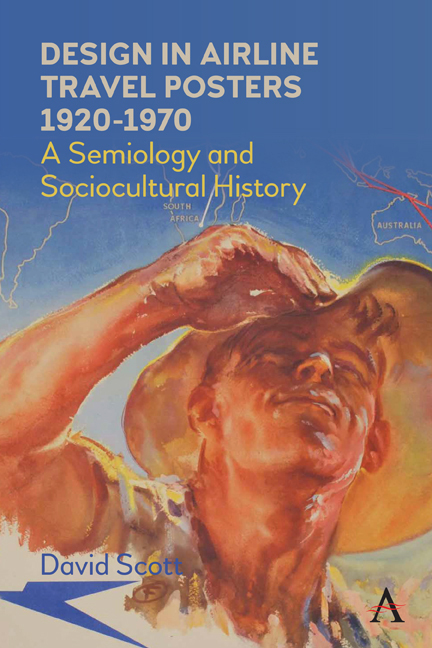Book contents
- Frontmatter
- Dedication
- Contents
- List of Figures
- Introduction
- 1 Fact and Fantasy: Reading and Misreading the Poster Image
- 2 People, Places and Planes: Destinations and Itineraries
- 3 Looking Out and Looking Up: Framing Devices and Indexical Signs
- 4 Indigenous Peoples
- 5 Glamour and Sex Appeal: Designing Desire
- Conclusion: The Decline of the Airline Travel Poster
- References
- Index
5 - Glamour and Sex Appeal: Designing Desire
Published online by Cambridge University Press: 09 February 2021
- Frontmatter
- Dedication
- Contents
- List of Figures
- Introduction
- 1 Fact and Fantasy: Reading and Misreading the Poster Image
- 2 People, Places and Planes: Destinations and Itineraries
- 3 Looking Out and Looking Up: Framing Devices and Indexical Signs
- 4 Indigenous Peoples
- 5 Glamour and Sex Appeal: Designing Desire
- Conclusion: The Decline of the Airline Travel Poster
- References
- Index
Summary
If as Oscar Wilde asserted ‘Dandyism is the assertion of the absolute modernity of beauty’, then glamour may be similarly defined in relation to feminine attractiveness. As a term, glamour began to be widely used after World War I with the rise of Hollywood cinema and still photography, and it implies a certain element of contemporaneous artificiality: make-up, hair styling, grooming, fashionable clothes are all important elements of glamorization. Although male film stars were submitted to a grooming almost as thorough as Hollywood goddesses, glamour nevertheless remains a primarily feminine attribute, although it can with a provocative edge also be applied to men, especially those who find themselves in the limelight of celebrity in sport or the entertainment business. Men in the public eye, like men in military uniform ready for inspection, have always been expected to look smart. When, in the twentieth century, women started wearing military uniforms (which apart from the substitution of skirts for trousers more or less followed the standard male pattern), masculine smartness became a prerequisite aimed in part at somewhat toning down feminine attractiveness. So early airline hostess outfits, when they were not, as they were in American airlines of the 1930s, modelled on nurses’ uniforms, exhibited a certain masculine severity (Figure 5.1) that was, however, softened by the pretty, discreetly made-up, feminine face.
The contrast between masculine uniform and feminine attractiveness is perfectly allegorized in an Ansett poster of c. 1960 (Figure 5.2) in which a pretty, blond, blue-eyed airhostess stands next to a stereotypically tall and handsome airline pilot. The pilot wears the dark uniform (emblazoned with medal stripes as well as wings), the white-topped cap and spotless white shirt and black tie of a naval captain. The hostess wears an outfit that is a kind of parody of a uniform in which the soft grey-green serge of the cap and jacket is set off by an open-collared off-white blouse (the tie was omitted from most airhostesses’ uniforms from c. 1950). The pilot's direct gaze and firm facial expression contrast with the hostess's soft blue eyes and broader smile.
- Type
- Chapter
- Information
- Design in Airline Travel Posters 1920–1970A Semiology and Sociocultural History, pp. 97 - 112Publisher: Anthem PressPrint publication year: 2021



